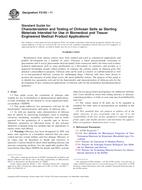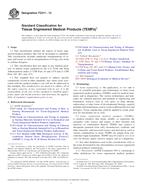Potřebujeme váš souhlas k využití jednotlivých dat, aby se vám mimo jiné mohly ukazovat informace týkající se vašich zájmů. Souhlas udělíte kliknutím na tlačítko „OK“.
ASTM F2383-11
Standard Guide for Assessment of Adventitious Agents in Tissue Engineered Medical Products (TEMPs) (Withdrawn 2020)
Automaticky přeložený název:
Standardní Příručka pro posuzování cizích agens v tkáňového inženýrství léčiv (brigádníků)
NORMA vydána dne 1.3.2011
Informace o normě:
Označení normy: ASTM F2383-11
Poznámka: NEPLATNÁ
Datum vydání normy: 1.3.2011
Kód zboží: NS-53728
Počet stran: 9
Přibližná hmotnost: 27 g (0.06 liber)
Země: Americká technická norma
Kategorie: Technické normy ASTM
Kategorie - podobné normy:
Anotace textu normy ASTM F2383-11 :
Keywords:
adventitious agents, microorganisms, TEMPs, testing, Tissue engineered medical products (TEMPs), TEMPs (tissue engineered medical products), Adventitious agents, ICS Number Code 11.100.99 (Other standards related to laboratory medicine)
Doplňující informace
| Significance and Use | ||||||||||||||||||
|
TEMPs may be composed of biological products (for example, human cells, organs, tissues, derivatives, and processed biologics), biomaterials (for example, substrates and scaffolds composed of polymers or collagen), and biomolecules (for example, recombinant proteins, alginates, and hyaluronates) (see Terminology F2312). Those TEMPs that contain human viable cells, organs, or tissues differ in terms of adventitious agent safety from other TEMPs because of the need to preserve viability of the organ, tissue, or cellular components. The need for preservation of viability limits processing options for the reduction or elimination of adventitious agents. Examples of TEMPs are listed in Classification F2211. To ensure production and use of TEMPs with minimal risks associated with microorganisms and other adventitious agents, a multi-tiered approach is required. Donor testing, as well as testing of components and raw materials by sufficiently sensitive assays that are state of the art is usually necessary. Compliance with good manufacturing practices (GMPs) and good tissue practices (GTPs), where applicable, is required (21 CFR 210, 211, 820, 1270, and 1271). Although some of the components of the TEMPs may be processed to remove potential microbiological contaminants, viable tissues and cellular components are generally unable to withstand rigorous processing without losing functionality. For those TEMPs containing tissues or cells for which banking is not possible, even greater reliance on donor screening, component testing, and manufacturing controls is required. When more upfront testing is possible, there is generally greater confidence in the safety of the final product. Process validation can enhance confidence in the ability of the TEMPs' producer to minimize risks from adventitious agents. Throughout this guide, the reader is referred to other documents that may provide specific information that can be applied in the manufacture and testing of TEMPs. Although many of these documents were not written with TEMPs in mind, parts are often applicable. Most of the potentially applicable position papers and guidance documents from many regions of the world can be accessed via the internet. New documents are continually produced. The MDCA (U.K. Medical Devices Agency, now part of MHRA, Medicines and Healthcare Products Regulatory Agency) Code of Practice for the Production of Human-Derived Therapeutic Products provides information on quality control, microbiological safety of donations, production, and processing practices. Two Rijksinstituut voor Volksgezondheid en Milieu (RIVM) reports provide valuable information. One of these reports addresses preclinical safety assessment of TEMPs, and the other provides an approach to risk management for TEMPs (1, 2). References may be made to draft guidances and rules. These should not be read as requirements. |
||||||||||||||||||
| 1. Scope | ||||||||||||||||||
|
1.1 This guide is intended as a resource for individuals and organizations involved in the production, delivery, and regulation of tissue engineered medical products (TEMPs). The safety from contamination by potentially infectious adventitious agents is important in the development of all TEMPs as well as their components. This guide addresses how to assess safety risks associated with adventitious agents and their byproducts. These agents currently include bacteria, fungi, mycoplasma, viruses, endotoxins, transmissible spongiform encephalopathies (TSEs), and parasitic organisms. This guide does not address TEMPs with live animal cells, tissues or organs, or human cells, including stem cells, grown on any animal feeder cells. Also excluded is patient follow-up testing. 1.2 This guide does not apply to any medical products of human origin regulated by the U.S. Food and Drug Administration under 21 CFR Parts 16 and 1270 and 21 CFR Parts 207, 807 and 1271. This guide does apply to cellular therapies regulated under the PHS (Public Health Service) act. 1.3 The values stated in SI units are to be regarded as standard. No other units of measurement are included in this standard. 1.4 This standard does not purport to address all of the safety concerns, if any, associated with its use. It is the responsibility of the user of this standard to establish appropriate safety and health practices and to determine the applicability of regulatory limitations prior to use. |
||||||||||||||||||
| 2. Referenced Documents | ||||||||||||||||||
|
Podobné normy:
Historická
1.9.2010
Historická
1.12.2012
Historická
1.3.2011
Historická
1.10.2013
Historická
1.3.2012
Historická
1.2.2013



 ASTM E1380-90(2010)..
ASTM E1380-90(2010).. ASTM E1440-91(2012)..
ASTM E1440-91(2012).. ASTM F2103-11
ASTM F2103-11 ASTM F2211-13
ASTM F2211-13 ASTM F2459-12
ASTM F2459-12 ASTM F2529-13
ASTM F2529-13
 Cookies
Cookies
